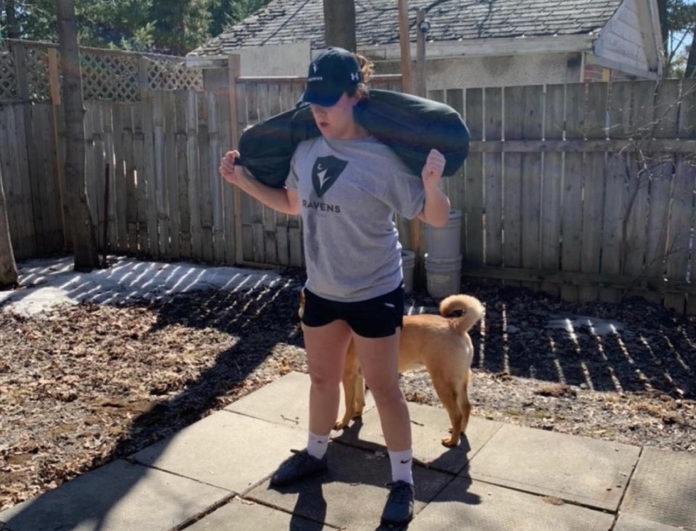While apps and devices encourage most students to lounge on the couch, online networking has been stirring Carleton student athletes to sweat rather than snooze in isolation.
The COVID-19 pandemic scattered members of every varsity sports team, barring them from training alongside their teammates. Gyms nationwide closed weeks ago to encourage social distancing, so access to exercise equipment is largely limited.
Nonetheless, the expectation remains that every Carleton athlete stay fit while confined to their homes. As a result, varsity athletes of every sport rely on workouts, issued by coaches and adapted for quarantine, from the app TeamBuildr to sustain proper training habits.
“I can’t say enough good about our strength and conditioning coaches and our coaching staff,” Ravens hockey player Justina Beard commented. “They motivate you, keep you going, hold everyone accountable.”
Carleton’s head strength and conditioning coach Nick Westcott designs and distributes unique workouts for varsity athletes depending on their sport. Athletes generally receive six workouts a week, targeting different muscle groups and skill sets, but all are manageable at home. Prescribed exercises range from cardio to free weight to body weight exercises, presenting a major adjustment for those attuned to the machines.
“It was a big challenge at the beginning because we didn’t know what to expect,” Ravens linebacker Louis Cavanagh admitted. “What were we going to do, a bunch of push-ups and run in the streets? But we got set up very well by our strength coach.”
Coaches’ involvement in training has been pivotal to keeping workouts rigorous for athletes. Left alone, students could theoretically opt for lighter, aimless exercises at home, but the workouts on the app are merciless.
“It’s very, very hard,” Cavanagh said. “I thought no added weights at all, no squat rack could be way easier than the gym, but when you actually do those workouts, it’s pretty difficult.”
TeamBuildr tracks and records the workout data from each athlete, including weights used, sets completed and times achieved for individual exercises. Coaches see these stats, so the motivation to impress already applies. Injecting some friendly competition into the workout, too, thereby only enhances athletes’ dedication.
“We have a two-kilometre run each week and a push-up and chin-up challenge where we can actually see each other’s numbers so we can compete,” women’s rugby player Joleen Mason explained. “It’s still that competitive gym-like attitude.”
If competition reinvigorated solo workouts for Carleton athletes, creativity plays an equally crucial role in keeping them fresh.
“They’re designed so we can do them with ease at home,” men’s soccer player Kelly Lowry said. “But sometimes you need to get a little creative. You use things as weights, use your staircase to do some calf raises, that kind of thing.”
Lowry purchased some dumbbells at the outset of his isolation, plus relies heavily on his treadmill. Beard tugs an old towel for resistance while she performs overhead squats. Women’s basketball player Kali Pocrnic exploits her overactive dog’s energy to run outside, and also routinely stretches, as advised by team athletic therapists.
Beyond giving these athletes a clear blueprint upon which they can build their workouts, connectedness online maintains team morale too. Officially, teams use digital tools to tackle team business.
The women’s rugby team uses the video conference app Zoom for meetings, while the Ravens football team relies on TeamSnap message boards for updates. Teammates themselves mainly cling together through social media group chats.
“We’re always in constant conversation and there’s always a good laugh going on in the group chat,” men’s soccer player Ricky Comba mentioned. “No one’s really left alone in these situations.”
Even Carleton athletes transferring to different schools next semester adhere to these digitally issued workouts. Although women’s hockey player Grace Tam will switch to the University of Alberta in the fall, for her, the online camaraderie is just as important as the calisthenics.
“I’m really close with the girls, so it’s great that social media and technology can keep us connected.”
Some athletes already have their sights set on the fall, placing paramount importance on the training they manage to accomplish at home despite the current craziness. Considering the football season, Cavanagh predicted that “the team with the most discipline at home will have the most success.”
Comba applied the same principle to the bigger picture, broadening the emphasis on communal fitness represented by TeamBuildr to encompass the entire health crisis.
“I feel like we’re doing the right things and I hope I can say the same thing for everyone, even beyond our team and athletics.”
Feature image provided.






